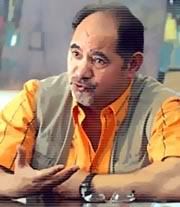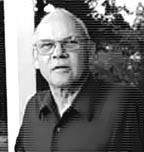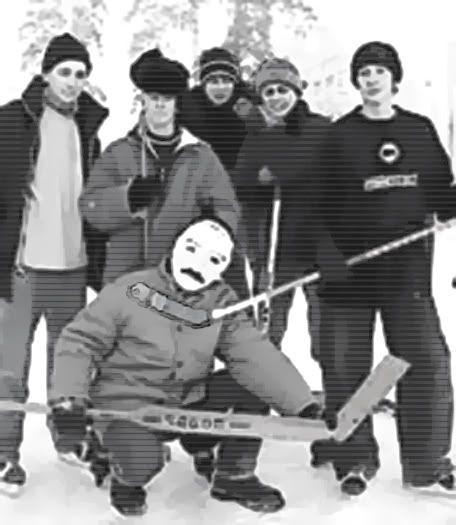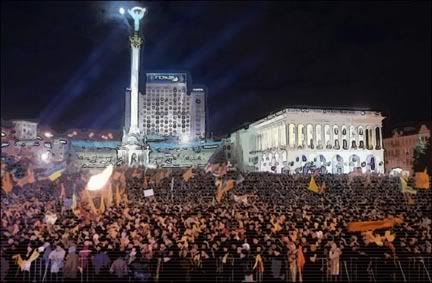Caustic Logic/Guerillas Without Guns
Posted April 11 2007
Ultimately weaponized nonviolence failed to replace outright war in Iraq, but that doesn’t mean some people didn’t push to give peace a chance to bring down the Butcher of Baghdad. As the long-suffering citizens of Iraq turned out for the October 2002 Presidential “election,” it was clear that there was little chance of change by that route. Banners across the country urged Iraqis to vote “Yes, yes, yes for Saddam,” a message reinforced by both outright State power and by state radio repetition of Hussein’s campaign song – reportedly I Will Always Love You by Whitney Houston, another sign of his relentless cruelty. [1] As with previous elections, marked ballots were used so those who voted no, no, no against Saddam would be known, and thus the Iraqi dictator hoped to match the 99.96 percent affirmation he had previously claimed. Exiled opposition leader Ismail Zayer described the election as “a forced pledge of loyalty […] The whole practice is a fiasco, orchestrated by a regime that does not believe in the people's voice. […] Their real voices, if given the choice, will say no to Saddam loud and clear.” [2]
 |
One demonstration he seems to have organized early on “really opened people's eyes.” Demonstrators in Baghdad shouted pro-Saddam chants as cover for taking over the streets, refusing to allow their patriotic display to be dispersed even by warning gunshots. Saddam was not looking for an excuse to crack down as the US war machine loomed, and so no one died. “Many thought such protests were not possible,” Zayer said, but they had been emboldened by the positive example. [6]
He had hoped initially to forge a millions-strong civil insurgency, and approached US decision-makers about helping him. While overall support remained muted and Zayer’s group received almost no media coverage even after the war, some influential people in the regime change industry did answer the call. John Bacher reported in Peace magazine that a seminar was held in 2001 to discuss the possibility of such a campaign. Hosted by Peter Ackerman’s Center for Nonviolent Conflict, Woolsey’s Freedom House, and the US Institute for Peace, this reported gathering occurred “almost a year after the successful nonviolent Serbian Revolution of 2000,” so right around the time of the September 11 attacks, one would presume before. Details like exact date, location, speakers and itinerary remain unclear, but it seems to have been in Western Europe.
This 2001 seminar was followed by a two-day workshop in Washington called “Prospects for Democratic Change in Iraq,” held at American University on May 24 and 25 2002. It was organized by the Iraq Institute For Democracy, based in “Iraqi Kurdistan” and sponsored by Freedom House. A tentative itinerary I located online listed the legendary Robert Helvey as set to speak right before lunch during session two, “Civilian-based Resistance and Regime Change in Iraq.” Jack DuVall and Peter Ackerman from the Center for Nonviolent Conflict were also to present in this session; collectively they were to address three topics: “1. The record of nonviolent conflict in bringing down a dictator 2. Developing a strategy for Iraqi civilian resistance 3. International assistance for civilian-based action in Iraq.” [7] At this session as in his earlier venture in Burma, Bacher explained, “Helvey's military experience helped persuade skeptical Iraqi exiles that nonviolence is a viable approach.” [8]
Helvey's strongest supporter at the May strategy session was reportedly Ismael Zayer, and for the next year Helvey proceeded to help him pursue the Third Choice, delivering preliminary training to 50 leaders of No to Saddam. [9] Presumably the group was considered a central element of any such planned upheaval, but “unfortunately,” Bacher reported, “[Zayer’s] effort was not assisted by other countries and only thousands of Iraqis took part - far short of the millions he had hoped for.” He diligently continued the crusade, asking European supporters to send monitors to future Iraqi elections. In a phone interview on the eve of the Iraq War’s commencement, Zayer pleaded that “to achieve the third choice, we need help. Not with armies or with money,” he explained from his home in the Netherlands. “We need help in the form of nonviolent training to protect ourselves from Saddam and his agents. We can do it, but we need help now.” [10]
Next: Washington’s answer: No to Zayer, Yes to Force Presence
Sources:
[1], [2] “In Iraqi vote today, choice is Hussein or ... Hussein.” St. Petersburg Times (Florida). Compiled from Times wires - published October 15, 2002. http://www.sptimes.com/2002/10/15/Worldandnation/In_Iraqi_vote_today__.shtml
[3], [4], [8], [9], [10] Bacher, John. “Robert Helvey's Expert Political Defiance”
Peace Magazine. Apr-Jun 2003, p.10. http://www.peacemagazine.org/archive/v19n2p10.htm
[5], [6], Bacher, John. “The Price for Peace: How a Cool $45 million could solve Saddam problem.” http://www.nowtoronto.com/issues/2002-12-05/news_story4.php
[7] Partial Schedule of event, found at: http://www.kurd.org/events/SinjariConf.html




